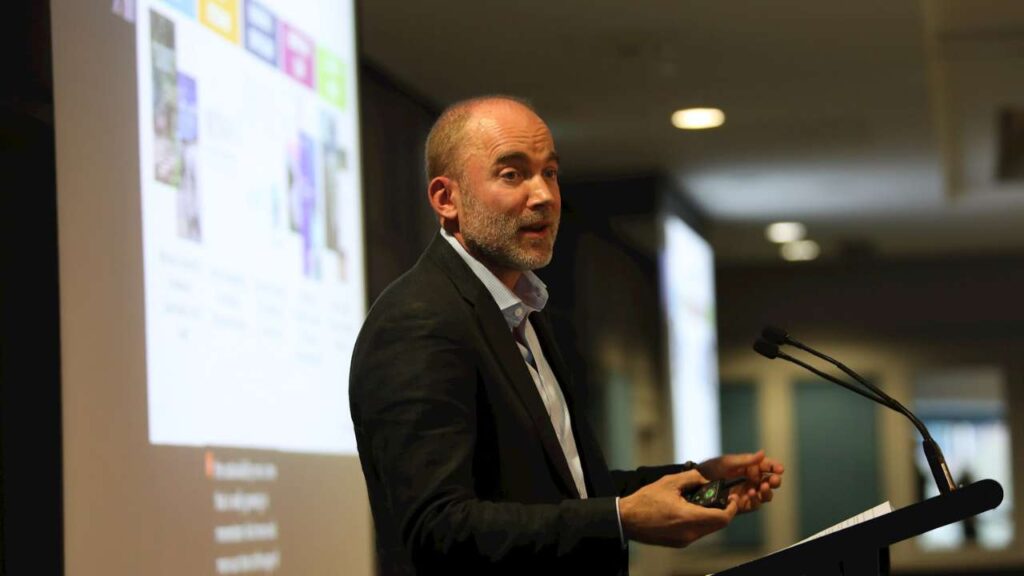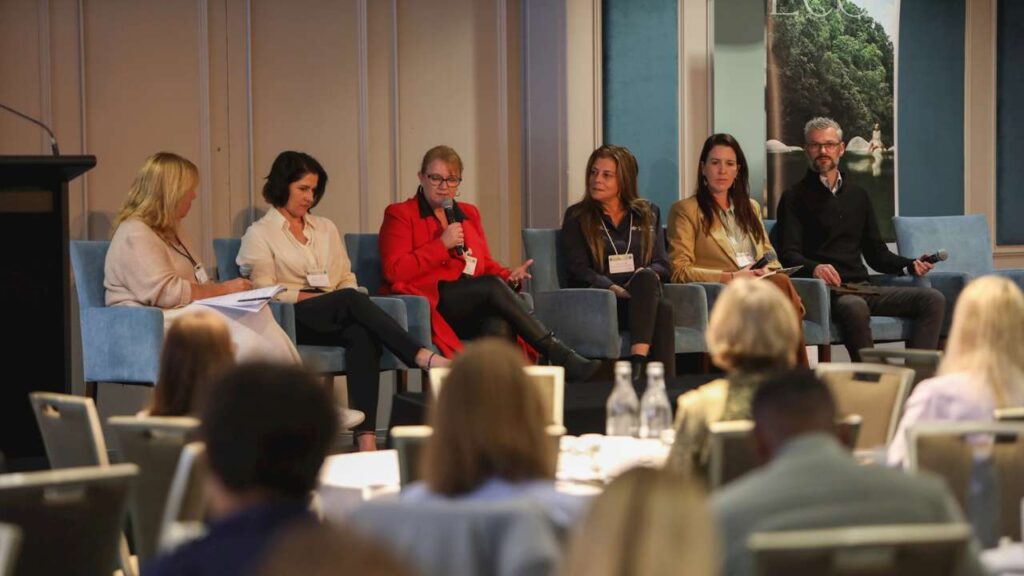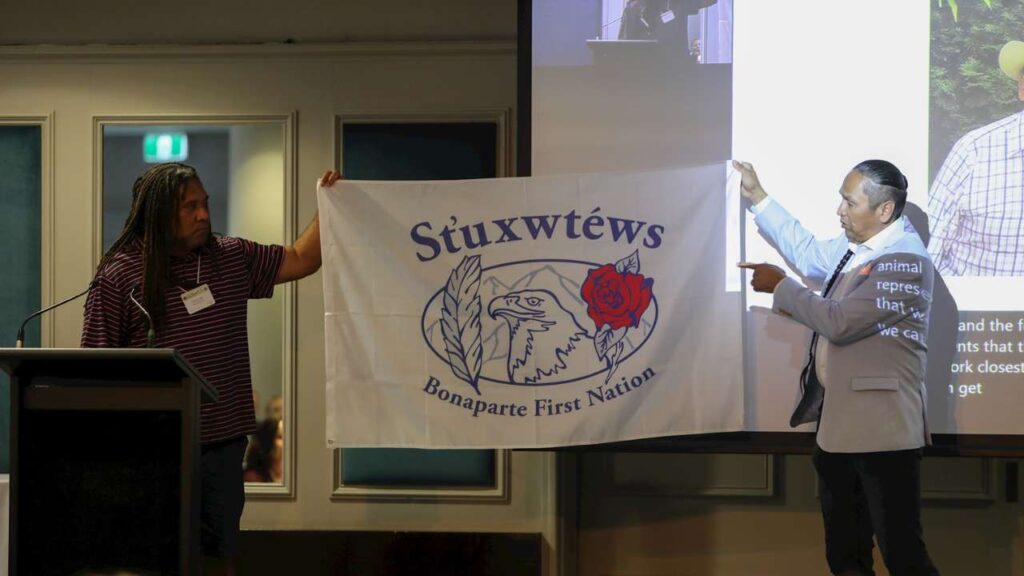Risks and opportunities for sustainable tourism was at the heart of Ecotourism Australia’s inaugural 2024 Global Sustainable Tourism Summit centred on the theme People, Planet, Place, Purpose. More than 280 passionate sustainable tourism operators and businesses, destinations, government departments and national park agencies, solutions providers, researchers, and conservation advocates congregated in Meeanjin/Brisbane for the event. Each state and territory in Australia as well as five internationalities were represented at the Summit, allowing attendees to gain a sense of the common challenges faced by the industry and how we can work together to overcome them.
In case you missed the Summit, or are looking to refresh your memory, we share our key takeaways from 62 speakers across the two days of conferencing.
Summit Day 1 Takeaways
On Summit Day 1 we opened the Summit with a Welcome to Country delivered by Shannon Ruska, who shared his story highlighting the diversity and value of Welcome Ceremonies. From Senator the Hon. Don Farrell, Minister for Tourism and Trade, attendees caught insights to the Australian government’s plan for sustainable tourism growth and their commitment to the industry before Bede Fennell of Tourism Australia shared the latest consumer trends as well as Tourism Australia’s own sustainability journey.
Chief Frank Antoine, Chief of the Bonaparte First Nation and founder of Moccasin Trails, dived into a case study of Indigenous Tourism Done Right sharing personal stories of his heritage and the role tourism plays in connecting us to each other and our past, present and future – “arrive as a guest, leave as family.” To round out the first session, David Young, Director of Sustainability at Accor Pacific revealed how the hotel industry is facing increased pressure to address environmental challenges from above and below resulting in Accor setting the ambitious goal to have all 406 of the region’s properties certified by 2025.

Bede Fennell, Executive General Manager of Corporate Affairs delivers the opening keynote presentation, The Future of Sustainable Travel. Credit: Mad Panda Media.
Fostering respectful partnerships with Indigenous communities through tourism took centre stage throughout the Summit program and Matt Cameron-Smith, CEO of Voyages Indigenous Tourism Australia, presented a case study of Wintjiri Wiru, emphasising Indigenous engagement isn’t just about talking to local communities, it’s about listening. Cliff Cobbo, First Nations Principal Advisor at WWF-Australia, noted by 2026, 50% of WWF-Australia’s work will be delivered in partnership with Indigenous people and organisations, while Annette Sharp, Global Social Impact Manager of Intrepid Travel, shared an inspiring good-practice case study from Machu Picchu about sharing iconic tourism experiences with residents.
After lunch, Julie Cheetham, Managing Director of Weeva, demonstrated how sustainable technologies are helping tourism operators to understand and measure their impact, followed by an impactful presentation from Flight Centre’s Global Sustainability Officer, Michelle Degenhardt, laying out her advice for a step-by-step guide to starting your sustainability journey. The third session concluded with a thought-provoking discussion about the Future of Air Travel with panelists exploring the Australia’s capability for Sustainable Aviation Fuels and the likelihood of electric flights for short route, small group flights in the next 10 years.
For the final session of the day, attendees dived into all things Sustainable Cruising where panelists explored the challenge of social license for cruise lines and how, with appropriate management and foresight, cruising can benefit and empower destinations and communities. Our next panel explored Regenerative Tourism and what it looks like in their business; panelist Nic Cooper of Wild Adventures Melbourne (WAM) shared their regenerative practices have a profound impact on guests and although customers don’t book because of their ECO Certification, 75% of visitors mention WAM’s sustainability actions in their post trip reviews. Our last discussion centred around Ecotourism Legacy Leaders with longstanding ECO Certified operators Steve Edmondson (Sailaway), Anthea Hammon (Scenic World) and Lizzie Corke OAM (Wildlife Wonders) revealing their lessons over the years. For example, Anthea shared how their ECO Certification is important to educate and achieve sustainability commitment from their staff.

At the Summit, Ecotourism Australia’s Board Chair Dr Claire Ellis presented Anthea with Scenic World’s Hall of Fame award, recognising the business’ achievement of 20 years continuous ECO Certification.
Our Summit Day concluded with the World Environment Day Cocktail Function hosted in partnership with Queensland Tourism Industry Council (QTIC) where attendees discussed learnings from the day, while feasting on delightful bites. The evening featured a panel conversation with Australian Age of Dinosaurs’ David Elliot OAM and Naomi Miles, exploring their business development and sustainability journey, including their designation as Australia’s first International Dark-Sky Sanctuary.
Summit Day 2 Takeaways
Bright eyed and eager to learn more, our attendees joined for a second day of the Summit, which took a deeper dive into the practical tips and tricks for sustainable tourism. Nadine Schramm, Head of Sustainability at Ecotourism Australia opened the day with insights from the pathway Strive 4 Sustainability Scorecard program and leaving delegates with the moving quote: “Sustainability takes forever, and that’s the point.”
Next was an informative discussion on the best ways to work with Indigenous communities to build tourism collaboratively. Chief Frank discussed the importance of connecting with multi generations to build community and share stories, and TRC Tourism’s Kylie Ruwhiu-Karawana engaging presentation reminded us to keep checking the back of the waka (Māori canoe) to ensure no-one’s been left behind on the consultation journey. Kingfisher Tours’ Rosie Sandover and Rebecca Sampi highlighted how engaging and championing Indigenous staff can empower them to “walk in our own way.” Gunditjmara Traditional Owner, Uncle Denis Rose, detailed Budj Bim Cultural Landscape’s UNESCO World Heritage journey and in particular how transparent communication with locals helped achieve buy-in, and, to round out the panel, Luke Barrowcliffe of Studio K’Gari outlined some of the challenges of Indigenous representation. Our Destination Best Practice panel followed, exploring challenges of overtourism, engaging local businesses on the sustainability journey and the need for effective partnerships.

Destination Best Practice Panel featuring from L-R: Janet Mackay (TRC Tourism; Facilitator), Simone Novello (Blue Mountains City Council), Lori Modde (Australian Regional Tourism), Fiona Merida (Great Barrier Reef Marine Park Authority), Whitney Edwards (Destination Central Coast), and Saul Cresswell (Shire of Augusta Margaret River). Credit: Mad Panda Media.
With the launch of Ecotourism Australia’s Sustainable Tourism Certification and Strive 4 Sustainability Scorecard in 2022, our audience is now larger than ever. Our second session of the day split into two breakouts; one for nature-based tourism and the other for urban tourism. Here are just three of our main insights from these discussions:
Nature Based Tourism Focus
- Accessibility in Nature Tourism – people with accessibility needs will make the best decision for themselves, don’t remove the sense of adventure by restricting or determining their access.
- The Future of Wildlife Tourism – seeing an animal in their natural habitat can be just as or even more thrilling than a ‘meet and greet’ animal experience, however educating guests to adopt an ‘observer’ rather than ‘interactor’ behaviour is crucial to its success.
- Developing High Quality Experiences Around Unique Australian Locations and Themes – creating a high quality experience involves affecting all the senses (touch, feel, sight, smell) to leave visitors with a lasting, positive memory.
Sustainability in All Destinations
- Sustainable Gastronomy and Food Tourism – it’s not just food and beverage providers that need to be held accountable for food waste, but also consumers and the choices they make at home.
- Sustainability in the Accommodation Sector – international hotel guests are increasingly asking for eco credentials and sustainability action across all accommodation classifications.
- Leading Sustainable Tourism Examples in Urban Environments – starting the sustainability journey might be the hardest step, but it is the most rewarding.
Quentin Long, Managing Director at Australian Traveller Media, energised the audience with his impassioned presentation exploring the sustainability ‘say-do’ gap, however he noted that when businesses lead with sustainability at the forefront, consumers will follow. Austrade’s Head of Visitor Economy Sustainability, International Markets and Tourism Research, Grant Ferres, shared Tourism Research Australia plan to release a dashboard in the coming months to track indicators including against key sustainability outcomes. Our penultimate panel explored Sustainable Distribution Channels with a clear message that international buyers and wholesalers are looking for validated and reliable eco credentials that are easy to identify. Our final panel, Creating a Net Positive Impact – Alternatives to Offsetting, left the audience on a high note, with Jenny-Lee Scharnboeck of Take 3 For the Sea sharing a positive impact story of their recent partnership with Norwegian Cruise Line in Fiji, where 80 cruisers, local police authorities and community members banded together to remove 514kg of litter from a single beach.

Sustainability in the Accommodation Sector panel featuring from L-R: Michael Johnson (Accommodation Australia; Facilitator), Paul McGrath (YHA Australia), Peter Johnson (Diamond Waters Treehouse Retreat), and Joanne Whitby-Lee (booking.com; out of camera). Credit: Mad Panda Media.
Risks and Opportunities from the Global Sustainable Tourism Summit
Throughout the event we asked our attendees to participate in an activity where they shared their risks, opportunities and solutions across the four pillars of sustainability that are impacting and driving the future of sustainable tourism. Results from this exercise identified common themes:
- Collaborate, engage and listen as an industry
- Joint voice led by a peak industry body like Ecotourism Australia
- The need for joint Australian expert leadership group on sustainability
- Talk less and do more – We are running out of time to be more sustainable! (2030 Sustainable Development Goals, Thrive 2030 etc)
- Storytelling – bridge the gap between visitors and sustainability
- Bring everyone (including businesses, local community and visitors) on the shared sustainability journey
- Listen to the younger generation and give them a seat at the table when developing sustainability plans
- Focus on thriving, not just mitigating negative impacts
- Enormous opportunities remain for regional areas to capitalise on positive socio-economic impacts of tourism
- Ban all single-use plastic items & encourage plastic free places across Australia
- Partnerships and collaborations across industry and sectors is key
- Authentic engagement
Events like the Global Sustainable Tourism Summit are so important to connect with all sectors of the tourism economy to learn from each other, and to discover the challenges organisations are facing and how they are working to overcome them.
Wrap Up Takeaways
To conclude, there were a number of impactful messages the reverberated throughout the Summit, that kept recurring again and again in presentations and through conversations. These are just a few of the best takeaways from the Global Sustainable Tourism Summit:
- “Tourism can help us save what we cannot afford to lose.” Tourism can be a powerful and inspirational mechanism for storytelling, conservation, and community-building, so long as we put People, Planet, Place and Purpose first.
- Tell your story. Sharing your journey and experiences fosters greater connection and change.
- “Look forward in the micro, look backward in the macro.” Take your sustainability journey one step at a time, and suddenly you’ll have walked a marathon.
- Authentic engagement is about listening. Showing up is one thing, but being present, purposeful and listening is another.
- Just start. Sustainability is not about perfection, it is a journey, but that journey cannot start without commitment. Start with what makes a difference to you.
- The land we stand on is the land we stand for.
- To lead we need to listen.
- Arrive as guests, leave as family.
- Plan for the visitor you want, manage the visitor you have

Chief Frank Antoine, Bonaparte First Nation Chief, (right) explains the symbols on the St’uxwtews flag, which was later gifted to Fraser Nai (Strait Experiences; left). Credit: Mad Panda Media.




